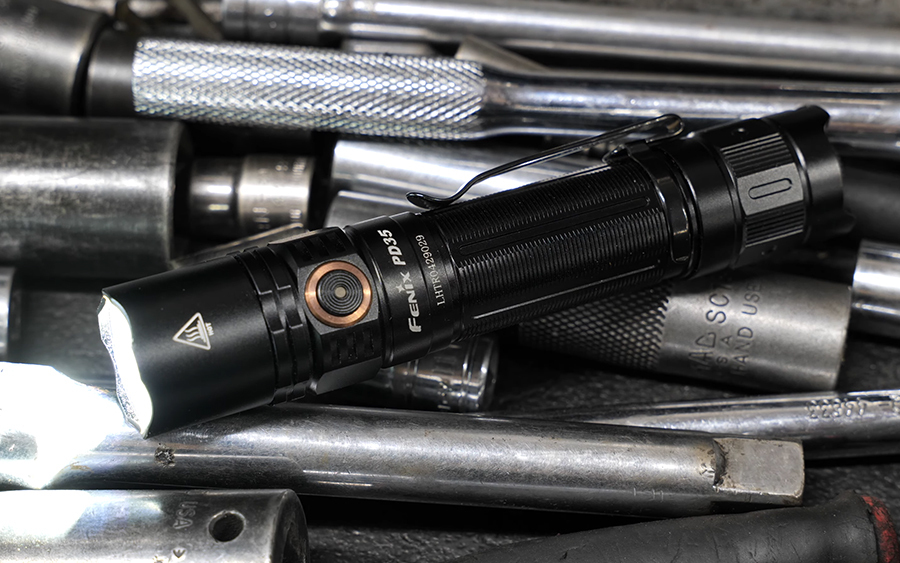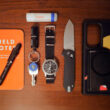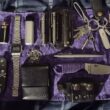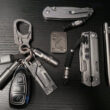With the weather getting colder and the nights getting longer here in the Northern hemisphere, it’s a great time to stop and take stock of your gear. There are a lot of different items that go into making sure your bases are covered. Plenty of people opt for a quality knife or multitool. Still, one often overlooked piece of EDC gear is a flashlight, which is interesting because you would carry an umbrella for a 20% chance of rain, but most people opt not to carry a light when there’s a 100% chance of darkness every day.
A light you can rely on can be handy whether you’re trekking through the wilderness, prepping for the next power outage, or walking the dog. Not to mention a small, super bright light can also come in handy for emergencies and is a way brighter and more purpose-built tool than the light on your phone. Whether you’re looking to fill a gap in your EDC or are looking to upgrade, this list of the best flashlights has you covered. A quality light you can trust doesn’t have to be unattainable.
Our Top Picks
The Best Overall Flashlight: Fenix PD34 V3.0 [Buy] / [Full Review]
The Best Flashlight on a Budget: Convoy S2+ [Buy]
The Best Keychain Flashlight: RovyVon Aurora A4x [Buy]
The Most Bombproof Flashlight: HDS Rotary [Buy]
The Best Flashlight for Enthusiasts: Emisar D4V2 [Buy]
Fenix PD35 V3.0 | Convoy S2+ | RovyVon Aurora A4x | HDS Rotary | Emisar D4V2 |
 |  |  |  |  |
| $$ | $ | $ | $$$$ | $ |
| Maximum Output: 1,700 lumens | Maximum Output: 440 lumens | Maximum Output: 650 lumens | Maximum Output: 250 lumens | Maximum Output: Up to 4,300 lumens |
| Emitter: Luminus SFT-40 | Emitter: Nichia 519A R9080 | Emitter: Multiple | Emitter: Cree XP-G2 | Emitter: Multiple |
| Key Features: Dual switch design | Key Features: Great modding platform | Key Features: Micro USB rechargeable | Key Features: Unique and programmable rotary interface | Key Features: Many, many tint and LED options |
| Buy Now | Buy Now | Buy Now | Buy Now |

Keychain Flashlight: Nitecore TINI 2
Purchase
Keychain Flashlight: RovyVon Aurora A4x Titanium
Purchase
AAA Flashlight: Skilhunt E3A High CRI
Purchase
AAA Flashlight: Prometheus Beta QRv2
Purchase
AA Flashlight: Skilhunt M150 High CRI
Purchase
AA Flashlight: AceBeam Rider RX Titanium
Purchase
CR123A Flashlight: HDS Rotary
Purchase
CR123A Flashlight: Sofirn SC21
Purchase
18350 Flashlight: Emisar D4V2
Purchase
18650 Flashlight: Fenix PD35 V3.0
Purchase
18650 Flashlight: Convoy S2+
Purchase
18650 Flashlight: Cloud Defensive MCH
PurchaseKey Features to Consider When Buying a Flashlight – How to Choose
Before finding the best flashlight for you, there are a few key things you should know. Not all flashlights prioritize the same features, so having a solid foundational knowledge of each term can help you pick the light best for you. You can learn something useful even if you don’t pick up a flashlight for yourself.
Brightness
You can’t talk about a flashlight without discussing how bright it gets. We measure brightness in lumens, which is how much light a source (like a bulb) emits. It’s hard to understand what this means without seeing it, so for reference, the flashlight on the back of the average smartphone is roughly 50 lumens when compared to our picks in this list.
Battery Life
Battery life is essential because it doesn’t matter how bright a flashlight can get if it has no power. Different battery types will provide different amounts of power. Plus, it also determines the minimum size that the flashlight needs to be. For example, a flashlight that accepts a AAA battery will likely be able to fit on your keychain, while other flashlights that need larger batteries need to rely on a pocket clip to be carried. Many flashlights on this list rely on CR123A batteries, which offer an above-average output and long runtime for their size, making them perfect for everyday carry.
Rechargeable Flashlight
If you don’t want to deal with replacing batteries every time the flashlight dies, you can always opt for a USB-rechargeable flashlight instead. These have built-in rechargeable batteries, so you can simply plug them into a charger when they die. These flashlights have benefits (like never needing to carry spare batteries with you) but also have downsides. If the battery dies while you’re out and about on a non-rechargeable flashlight, you can swap in a new battery and continue. With rechargeable batteries, you’ll need to wait before it has enough juice to keep going. Non-replaceable rechargeable batteries also mean your light has a finite lifetime and will need eventual replacing when its battery degrades and no longer has any usable capacity.
Light Output Type
If you really want to get down and dirty with flashlights, you should always know a little about the types of light output. Flashlights typically use LEDs (light-emitting diode) and will be either CREE or Nichia, both of which are tried-and-true options.
Nichia bulbs tend to have a more natural-looking light, meaning objects you shine your light on will have a more faithful reproduction of color. Some lights will also have different color temperatures ranging from 2000K to 5000K. The higher the K value, the cooler (more blue) the light. Lower K value lights will have a warmer tint closer to candles or old incandescent bulbs.
If you want to really dig into the details, we recommend reading our guide to EDC flashlights.
Beam Distance
While a flashlight’s brightness is an important feature, you shouldn’t overlook beam distance. This is how far your flashlight beam can reach, just like it sounds. If you’re only looking for whatever fell under your couch, this probably won’t matter to you, but the next time you’re looking for something outside, you’ll thank yourself for getting a flashlight with a decent throw.
Water-resistant
Flashlights use electronic components and electric currents, and electricity famously does not get along with water. Getting a flashlight that is at least water-resistant (or at best waterproof) will mean that your new light won’t get destroyed by the first passing raincloud. A typical flashlight is fairly water-resistant already, but flashlights with a waterproof Ingress Rating (IP) will have the upper hand in a gloomy downpour.
Form Factor
Flashlights come in all shapes and sizes. The ones on this list are standard lights that will fit on your keychain or in your pockets, but there are also other kinds. If you’re someone that prefers a light that you can use hands-free, then what you might need is a solid headlamp instead. If that sounds like you, check out our list of the best headlamps you can get.
Tactical Flashlight vs Normal
There are key differences between tactical flashlights and normal EDC flashlights. The main ones are that tactical flashlights are typically much larger, heavier, and have a strike bezel. They tend to be purpose-built for the most intense situations where the emphasis is on toughness over how easy they are to carry (think law enforcement). EDC flashlights place more value on being big enough to be effective but small enough that you can carry them daily. Tactical flashlights can also get extremely bright, so it might be a little impractical for someone simply taking the dog for a walk.
Best Flashlights FAQ
What is the best flashlight on the market?
If you want a powerful light with proper modes and a reasonable price, then the best flashlight is the Fenix PD34 V3.0. It won’t break the bank, and it lives comfortably in the gray area between being a small, pocketable flashlight and a large tactical one, while still offering many solid features.
What brand of flashlights do police use?
While this answer differs between places, a popular option is Streamlight.
What flashlights do Navy SEALs use?
Navy SEALs tend to use more tactical lights due to the need for brighter output, rugged build quality, and waterproofing.
What are the most popular flashlights?
While MagLite had a moment back in the day, the most popular flashlights now come from brands like Streamlight, SureFire, Fenix, and, Olight.
What are the best flashlights for camping?
The best flashlight for camping is something like the Sofirn SC21. You’ll want something that can get wet, get bright, and last long. This flashlight checks all three. It’s small enough to be comfortable to carry with you at all times but powerful enough that you can rely on it in the pitch black of the woods.
How we picked
Decades of experience and deep connections in the everyday carry industry give us a unique viewpoint on the market to inform our product recommendations. We have the depth of information for thousands of products that have come before and an extensive eye on the market to see what’s new and trending for each piece of gear. The result is a buying guide that we feel is informative and useful for EDCers of every trade, industry, and budget.
What is Everyday Carry?
Everyday Carry is both the concept of what people carry in their pockets and the process of picking out gear that thoughtfully considers what one wants or needs in their daily lives. It encompasses everything from style to preparedness to utility, meaning an entire industry full of valuable tools and essentials to choose from.
Why you should trust us
Our team has decades of combined experience in all aspects of everyday men’s essentials, from wallets to pens to bags and everything in between, and we know where to find great gear ideas that you may not come across at your local stores or when shopping online. Our expertise with the industry and familiarity in design, materials, and usability help you make more informed choices when it comes to picking up your next piece of gear.









